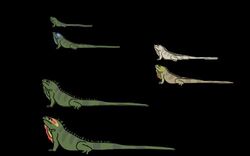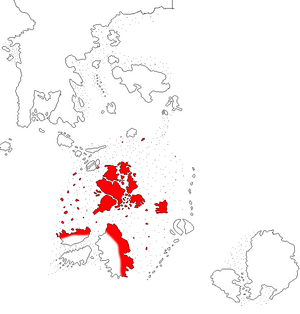Mosh’shalash: Difference between revisions
(Created page with "{{Taxobox | name = Mosh’shalash | status = NT | status_system = IUCN3.1 | extinct = | image = Mosh’shalash.jpg | image_width = 250px | image_caption = The three Mosh’shalash species, the greater, sand, and blue | regnum = Animalia | phylum = Chordata | classis = Reptilia | ordo = Squamata | familia = Mosh’shalashide | binomial_authority = Hylfred Görenssen, 1785 | range_map=Hog_habitat.png | range_map_caption= Habitat }} The Mosh’shalash or lajanadla in...") |
No edit summary |
||
| Line 1: | Line 1: | ||
{{Taxobox | name = Mosh’shalash | status = NT | status_system = IUCN3.1 | extinct = | image = Mosh’shalash.jpg | image_width = 250px | image_caption = The three Mosh’shalash species, the greater, sand, and blue | regnum = Animalia | phylum = Chordata | classis = Reptilia | ordo = Squamata | familia = Mosh’shalashide | binomial_authority = [[Hylfred Görenssen]], 1785 | range_map= | {{Taxobox | name = Mosh’shalash | status = NT | status_system = IUCN3.1 | extinct = | image = Mosh’shalash.jpg | image_width = 250px | image_caption = The three Mosh’shalash species, the greater, sand, and blue | regnum = Animalia | phylum = Chordata | classis = Reptilia | ordo = Squamata | familia = Mosh’shalashide | binomial_authority = [[Hylfred Görenssen]], 1785 | range_map=SHALOSHHABITAT.png | range_map_caption= Habitat }} | ||
The Mosh’shalash or lajanadla in Scanderan is a clade of predatory lizards that serve the roles of medium and large ambush predators in the island rainforests and jungles that dot Vatnahafet. There exists three species, the greater Mosh’shalash, the sand Mosh’shalash, and the blue Mosh’shalash. All three are ambush hunters and and make their homes either in the jungle floor in the case of the greater Mosh’shalash, the shorelines in the case of the sand mosh’shalash while the most derived species, the blue Mosh’shalash make their home both on the forest floor but also in the trees and are well known to drag kills up in the treetops to avoid having their prey stolen by larger predators. | The Mosh’shalash or lajanadla in Scanderan is a clade of predatory lizards that serve the roles of medium and large ambush predators in the island rainforests and jungles that dot Vatnahafet. There exists three species, the greater Mosh’shalash, the sand Mosh’shalash, and the blue Mosh’shalash. All three are ambush hunters and and make their homes either in the jungle floor in the case of the greater Mosh’shalash, the shorelines in the case of the sand mosh’shalash while the most derived species, the blue Mosh’shalash make their home both on the forest floor but also in the trees and are well known to drag kills up in the treetops to avoid having their prey stolen by larger predators. | ||
Revision as of 11:25, 13 November 2024
| Mosh’shalash | |
|---|---|

| |
| The three Mosh’shalash species, the greater, sand, and blue | |
| Scientific classification | |
| Kingdom: | Animalia
|
| Phylum: | Chordata
|
| Class: | Reptilia
|
| Order: | Squamata
|
| Family: | Mosh’shalashide
|

| |
| Habitat | |
The Mosh’shalash or lajanadla in Scanderan is a clade of predatory lizards that serve the roles of medium and large ambush predators in the island rainforests and jungles that dot Vatnahafet. There exists three species, the greater Mosh’shalash, the sand Mosh’shalash, and the blue Mosh’shalash. All three are ambush hunters and and make their homes either in the jungle floor in the case of the greater Mosh’shalash, the shorelines in the case of the sand mosh’shalash while the most derived species, the blue Mosh’shalash make their home both on the forest floor but also in the trees and are well known to drag kills up in the treetops to avoid having their prey stolen by larger predators.
Etymology
The Imerian name Lajanadla directly translates to Lion lizard, a term reflecting that the lizard has a somewhat similar niche as great cats does in Scandera and Asterland. Mosh’shalash in the zunzhal translates from a more archaic form of the language into “redthroat”, a reference to the colourful throats of the lizards. They are at times also called Jarlaadla due to often being considered “The Jarl of the jungle” by Scanderans, a reference to lions being considered “The Jarl of the plains” by Scanderans and Asterlanders.
History
Often being considered dangerous and fearsome creatures by most federals due to their tendency for being maneaters are at times hunted and also eaten in turn, especially the rich and wealthy nobility of the south have been known to slay these great bests as martial displays. However this practice is also very dangerous, as a wounded beast that survives any retaliation or attack is very likely to turn maneater due to their injuries. By Scanderans they are seen as very exotic and their colourful scales are known to be used as decorative coats, cloaks, and boots. The blue Mosh’shalash is also kept as displays in gardens in Vattnafalten as a means to keep other lizards from overpopulating said gardens and as an exotic display piece.
Reproduction
All three species practices a r-selective breeding with females laying large clutches of eggs that are later on abandoned and newborn are hatched able to walk and hunts, often starting out in smaller groups of siblings until they reach adulthood.
All species do however have large nesting colonies that males and females return to during breeding seasons. Males tend to compete by displaying their colourful throats and dancing. Combat between males happens but it is rare and often the smaller male backs off during these mating displays. When the period is over and the females have laid their eggs does most of the lizards leave to spread out over the islands while the young once hatched tend to stick around the mating area until their first mating season.
Diet
All three species are documented hyper carnivores and subsides entirely on small and mid sized prey. The blue Mosh’shalash is known to favour smaller and mid sized lizards, mammals, and even insects as part of it’s hunting tactics, and are dependent on dragging their prey up into the trees which means that they are restricted to prey they can actually carry.
All three species are well known for their unusually strong bites and they have very thick muscles on their neck that enables them to deliver a crushing bite and they eat most of the animals they catch including bones. Being generalist predators means that they don’t have any specific prey they hunt and the greater Mosh’shalash is well documented to eat humans if they can attack them.
Behaviour
Being cold blooded are the Mosh’shalash not in need of as great a caloric intake as mammals and can as a result subside on a much smaller diet. This means that they are not particularly territorial and they are known to wander the islands lazily or sleep in the sun when they are not lying in ambush, something that they tend to do around dawn and evening. This lack of urgency when it comes to hunting means that they can sustain not only a larger population but also a greater population density than a mammal species of the same size can, making them common predators and further adding to the dangers of the jungles.
Life expectancy
The tan and blue Mosh’shalash gets to be around 10 years old but the Greater Mosh’shalash can reach up to 20 years of age. One example held at the great library is especially noteworthy of reaching the age of 30 and can currently be visited in their zoological garden and he has been named “Goran alde basten” or “Goran the old beast” and is a popular tourist attraction but also a beloved feature of the garden by students, there is a widespread belief that it’s good fortune to feed him meat prior to exams which has caused an ongoing arms race between his keepers and students in an attempt to offer up offerings to him and to stop said offerings. Ultimately has this caused a noteworthy trend for the old beast to gain a few kilos come exam season.
To combat this the great library set up a shrine dedicated to his spirit to allow people to offer up sacrifices to a fetish of Goran which is growing more and more popular but has not entirely stopped students from feeding the beast.